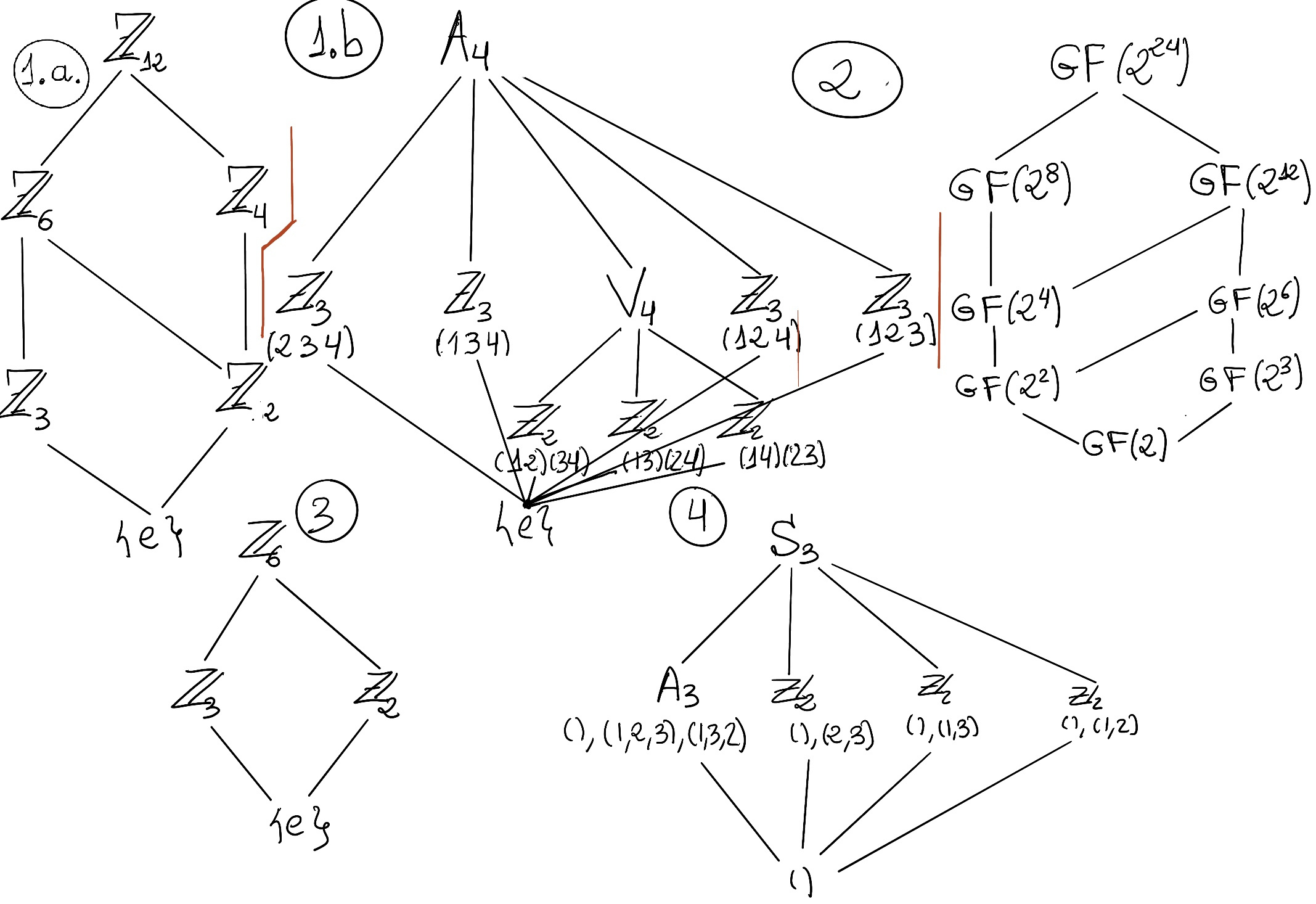
|
 |
 |

|
 |
 |
Over the millennia, across the Universe’s vast size, in its infinite words, thinkers (those who think it should be done), mathematicians (those who demonstrate that can be done), engineers (those who actually get it done), and philosophers (those who wonder what the hell has been done and why) have long struggle to find universal truths, Apocalypse, Anawim, #justtothepoint.

Classification of finite fields. For each prime p and each positive integer n, there exist a unique finite field E of order pn, up to isomorphism.It is isomorphic to the splitting field of xpn-x over ℤp.
Proof.
Consider the polynomial f(x) = xpn-x, and let F be the splitting field of f(x) over ℤp (and therefore char(F) = p).
f’(x) = pnxpn-1-1 =[In a field of characteristic p] -1, and -1 is obviously relatively prime to f(x) ⇒ f(x) is separable, i.e., has pn distinct zeros in F.
We claim that the roots of f(x) form a subfield of f.
Therefore, the roots of f(x) form a subfield of F and F is the splitting field of f(x) ⇒[A splitting field of a polynomial is the smallest field extension of that field over which the polynomial splits] the subfield must be all of F, i.e., |F| = pn.
To show that there is a unique field for each prime-power up to isomorphism, let E be any other field of order pn, let’s show that E is isomorphic to F, we must prove that every element in E is a root of f(x).
0 is a root of f(x). Let α ≠ 0, α ∈ E, the order of the multiplicative group of non-zero elements of E is pn-1, p prime ⇒ [The multiplicative group of non-zero elements of a finite field is cyclic -see the theorem just below-, hence the order of α is a divisor of pn-1] αpn-1 = 1 or αpn - α = 0.
Since E contains pn elements ⇒ E is the splitting field of f(x), and we know that the splitting field of any polynomial is unique up to isomorphism. Therefore, there is only one field for each prime-power pn, we denote this field by $\mathbb{F}_{p^n}$ GF(pn), and call it the Galois field of order pn

Theorem. Let p be a prime. Then, a field of order pn contains a field of order pm ($\mathbb{F}$pm ⊆ $\mathbb{F}$pn) iff m|n.
Proof. Assume $\mathbb{F}$pm ⊆ $\mathbb{F}$pn. Then, n = [$\mathbb{F}$pn:$\mathbb{F}_p$] = [$\mathbb{F}$pn:$\mathbb{F}$pm][$\mathbb{F}$pm:$\mathbb{F}$p] = [$\mathbb{F}$pn:$\mathbb{F}$pm]m, thus m | n.
Conversely, assume m | n, that is, km = n. Let α ∈ $\mathbb{F}$pm ⇒ αpm = α and consider f(x) = xpn -x.
Reclaim that $\mathbb{F}$pn is the splitting field of xpn -x. In other words, an element belongs to the field $\mathbb{F}$pn ↭ if this element is a root of the polynomial xpn -x.
∀α ∈ $\mathbb{F}$pm, f(α) = αpn -α = [n = km] αpkm -α = α(pm)k = α(pm)··k times··(pm) -α = $(α^{p^m})^{p^m}…^{p^m}$ -α = [α ∈ $\mathbb{F}$pm ⇒ αpm = α] α - α = 0 ⇒ α ∈ $\mathbb{F}$pn ⇒ $\mathbb{F}$pm ⊆ $\mathbb{F}$pn ∎
Th. The Multiplicative Group of Finite Subgroups of a Field. Let F be a field and G a finite subgroup of F*, the multiplicative group of non-zero elements of F, then G is cyclic. In particular, the multiplicative group of all nonzero elements of a finite field is cyclic.
Proof.
Let |G| = n, a finite subgroup of F* of order n. F is a field ⇒ F* is an Abelian group ⇒ G is a finite Abelian group ⇒ [Fundamental Theorem of Finite Abelian Groups] $G ≋ ℤ_{p_1^{e_1}}x···xℤ_{p_k^{e_k}}$ where $n = p_1^{e_1}···{p_k^{e_k}}$ and the pi are (not necessarily distinct) primes.
Let m be the least common multiple of the orders of the cyclic factors of G, $p_1^{e_1},···,{p_k^{e_k}}$ ⇒ m ≤ $p_1^{e_1}···{p_k^{e_k}}=n$. If ai ∈ ℤ(pi)ei, then (ai)(piei) = 1 ⇒[m = lcm($p_1^{e_1},···,{p_k^{e_k}})$ ⇒ m is a multiple of piei] aim = 1 ⇒ ∀α ∈ G, αm=1, that is, every element of G is a root of xm = 1.
Since xm-1 has at most m roots in F ⇒ n ≤ m ⇒[Before we have established that m ≤ n] n = m ⇒ m = lcm($p_1^{e_1},···,{p_k^{e_k}})$ = n =[$G ≋ ℤ_{p_1^{e_1}}x···xℤ_{p_k^{e_k}}$] $p_1^{e_1}···{p_k^{e_k}}$ ⇒ lcm($p_1^{e_1},···,{p_k^{e_k}})$ = $p_1^{e_1}···{p_k^{e_k}}$. Therefore, pi’s are distinct primes, and the group G is isomorphic to the cyclic group ℤm ∎
In particular, I insist, the multiplicative group of all nonzero elements of a finite field is cyclic.
Besides, if F is a finite field, then there exist some element α ∈ F (it is called a primitive root of F) which is a generator of F*, that is, all nonzero elements of F are expressible as a power of α. In particular, if characteristic(F) = p, then F = $\mathbb{F}_p(α)$ which is a simple extension.
f(x) = x2 + x + 1, $\mathbb{F}_2$[x]/⟨(x2 + x + 1)⟩ = [Notation] $\mathbb{F}_2$[w]/⟨(w2 + w + 1)⟩ is a field of order 4. Its elements are 0, 1, w -Abusing notation, x + ⟨(x2 + x + 1)⟩-, w +1, where w2 = w + 1.
f(x) = x3 + x + 1, $\mathbb{F}_2$[x]/⟨(x3 + x + 1)⟩ is a field of order 8. The eight polynomials of degree less than 3 in ℤ2[x] form a field with 8 elements, namely, 0, 1, x, x +1, x2, x2 + 1, x2 + x, x2 + x + 1.
f(x) = 1 + x + x4 ∈ ℤ2[x]. We claim f(x) is irreducible because f(0) = f(1) = 1 and f(x) ≠ (x2 +x +1)2 and this is the only irreducible quadratic. Therefore, $\mathbb{F}_2$[x]/⟨f(x)⟩ ≋ F(α) is a field of order 24 = 16 -its base is {1, α, α2, α3} in ℤ2, α root of f-, ℤ2(α)= $\mathbb{F}$16 ≋ ℤ24 as vector spaces. Besides, $\mathbb{F}$*16 ≋ ℤ15 as groups.
α4 + α + 1 = 0 ⇒[ℤ2(α)] α4 = α + 1.
Theorem. Let F be a finite field of order q = pn. Then, F is the splitting field of the polynomial xq-x ∈ $\mathbb{F}_p[x]$.
Proof.
First notice that 0q = 0. Let u ∈ F* ⇒ [By Lagrange’s Theorem] u|F*| = 1 ⇒ uq-1 = 1 ⇒ [*u] uq = u. Then, every element of F is a root of f(x) = xq -x.
As f(x) has at most q roots, we see that F contains all the roots of f(x) ⇒ f(x) splits over F. As obviously F = $\mathbb{F}_p$(F), F is necessarily the splitting field of f(x).
Structure theorem for finite fields. Let p be a prime, n be a positive integer, q = pn. Then,
$\mathbb{F_4}$ = {0, 1, α, 1 + α}, α is a root of x2 +x + 1 (the only irreducible polynomial of degree 2 in $\mathbb{F_2}$).
A polynomial p(x) of degree 2 or 3 is irreducible ↭ it does not have linear factors. Therefore, it suffices to show that p(0)=p(1)=1. This quickly tells us that x2+x+1 is the only irreducible polynomial of degree 2 (0+0+1=1≠0, 1+1+1=1≠0), and x3+x2+1 and x3+x+1 are the only irreducible polynomials of degree 3.
By the Structure Theorem for finite fields (3), $\mathbb{F_4}$ is the splitting field of the polynomial x4 -x = [This equality holds in $\mathbb{F_4}$[x] not in $\mathbb{F_2}$[x]] x(x -1)(x -α)(x+α) = x(x3-1) = x(x -1)(x2+x+1).
x(x -1)(x2+x+1) are the three irreducible polynomials in $\mathbb{F_2}$[x] whose order divides 2.